Troubleshooting Your Motorcycle Battery
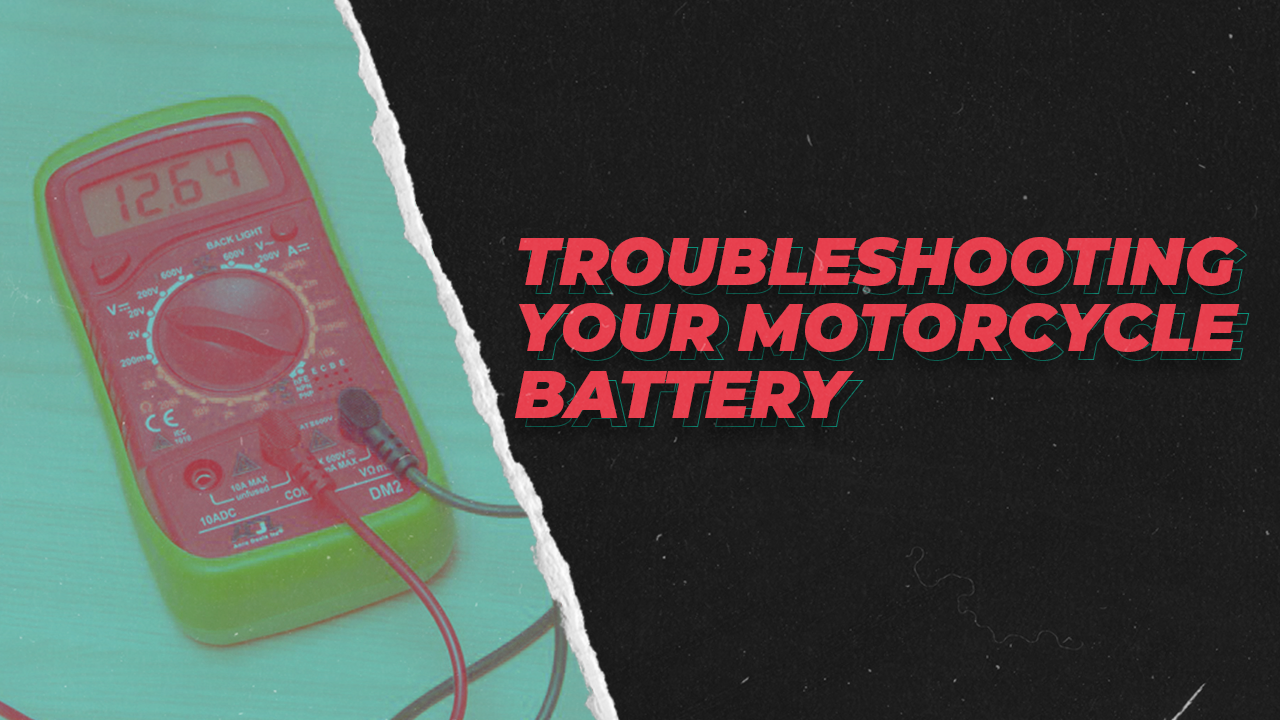
A motorcycle battery is a key component in your charging system. It is important to monitor the condition of your battery and charging system to ensure you don't have any issues down the road. Being able to identify whether the issue is with your battery or another component in the system is key to getting to the root of the problem quickly and efficiently.
Testing the Battery Voltage
Measuring Static Voltage
Before measuring the voltage of the battery, ensure it is fully charged. Using a multimeter set to 20v DC, check the voltage of your battery. With the engine off, touch the negative probe to the negative terminal of the battery and the positive probe to the positive terminal . Anything above 12.4v should be enough to start your bike. The ideal range for a battery is 12.6-14.4 volts. Anything below 12 volts is likely to be beyond saving.
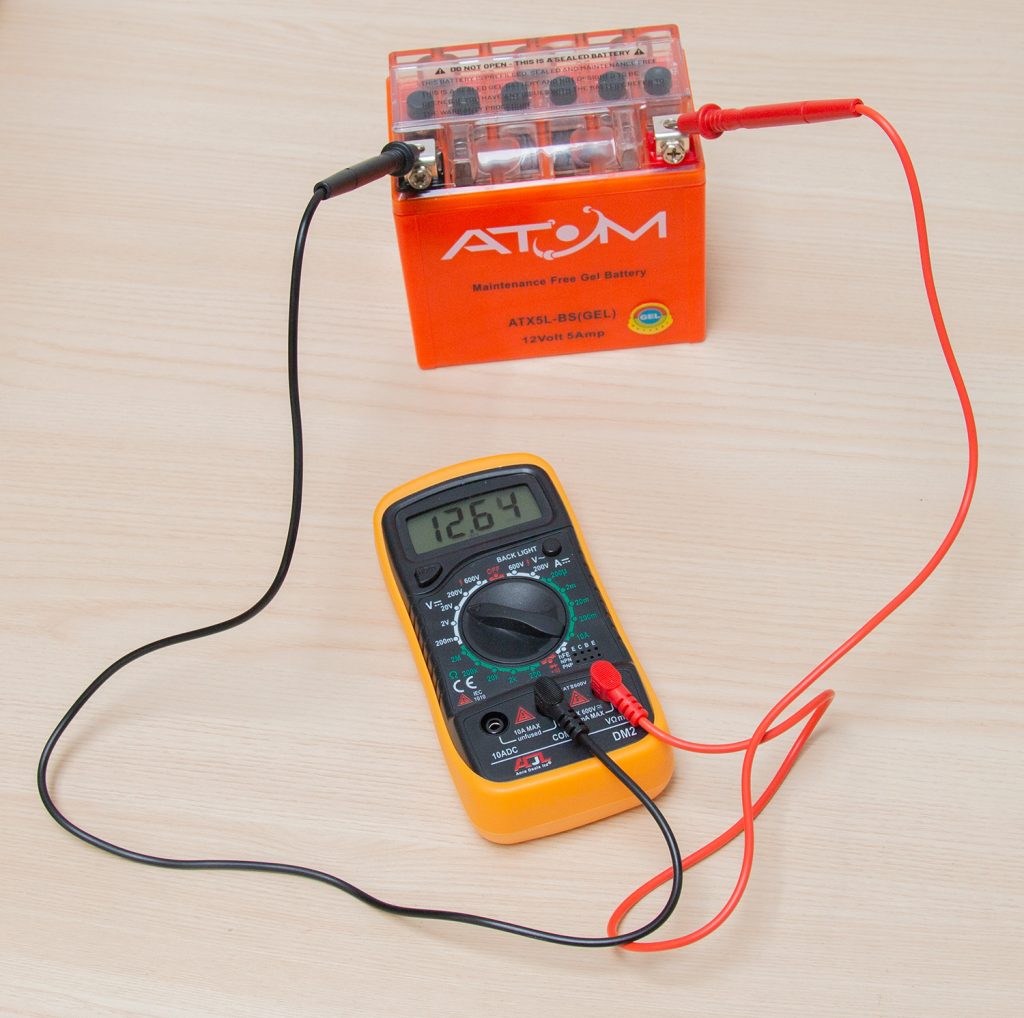
If your voltage measures around 10 volts, there is an issue with one of the cells of the battery. Modern motorcycle batteries consist of 6 cells, each with a voltage of around 2.1 volts (2.1 x 6 = 12.6v). If your reading shows 10 volts, it is a clear indicator that one of the cells is damaged. This can happen due to vibration over time, or overcharging amongst other things. If this is the case you'll need a new battery.

Running Voltage
Take the same measurement once you have started your bike. If the charging system is working properly, you should read at least 13.8 volts, with a maximum of around 15 volts - any lower than 13.8 will point to potential issues with the charging system. It is worth referring to a workshop manual for your bike to confirm the acceptable voltage range given by the manufacturer.
If you get a reading over 15 volts with your engine running, your reg/rec is likely faulty. Equally, a swollen battery is a big indicator that your reg/rec isn't regulating the amount of voltage it's sending to your battery.
Causes of Low Voltage When Running
If your battery reading is below 13.8 volts, there might be a break in the system somewhere, a poor ground connection, a blown fuse, or your alternator or reg/rec are not working. It is worth checking all connections are secure before any further troubleshooting. A loose connection can cause chaos. It is worth noting, even if you find one element of the system that isn't working, check everything! You might be incredibly unlucky and have a bad stator, reg/rec and battery all at once...
If your readings are outside of any of the given values, you'll need to do some further digging - see our other article on troubleshooting your charging system.
What Types of Motorcycle Battery Are There?
We go into this in more depth in our other article, but here is an outline of the types of motorcycle battery available on the market.
Lead Acid
This is the most bog standard type of battery. You need to fill these with electrolyte (acid) before use and can only be mounted in one orientation - upright. On the plus side, they are the cheapest you can buy. On the downside, you need to keep an eye on the electrolyte level to make sure it doesn't drop below the minimum level. This type of battery isn't really widely available these days. Due to government laws around battery acid, it is no longer possible to purchase these along with a separate acid bottle. They are also the most susceptible to vibration and tend not to last as long as the other available options.
Common use: vintage motorcycles and scooters
VRLA (Valve Regulated Lead Acid)
Valve regulated batteries are also known as sealed batteries. The general construction is similar to a standard lead acid battery, except that it features an internal valve system to manage gas venting. The battery is completely sealed. The discharge rate of lead acid batteries is higher than gel or AGM due to the construction of the plates. This is the most basic type of battery you can buy. They are more susceptible to vibration/damage than gel or AGM batteries.
Common use: Most motorcycles and scooters
Gel
Similar to a lead acid battery, they have had silica added to the acid in order to form a gel. They are more stable than lead acid (as there isn't acid sloshing about inside) and are also fairly cheap. They are fairly resistant to vibration. You can mount these on their side.
Common use: Most motorcycles and scooters
AGM (Absorbed Glass Mat)
AGM batteries tend to be the best all round option for most motorcycles. The acid is absorbed into glass fibre which is wrapped around the terminals of the battery. This results in a battery that tends to have higher cranking amps and is less susceptible to vibration and discharge. They tend to be more expensive than gel or lead acid, and heavier too. You can mount these on their side.
Common use: Adventure bikes and large capacity motorcycles
Lithium
Generally the most expensive option, lithium batteries are also the lightest, most powerful and the most resistant to discharge. If left for an extended period of time, they might need to 'wake up' first by turning your lights on for a minute before starting. You can mount these in any orientation. The downside is that they require a dedicated lithium charger and are pricey.
Common use: Racing/track bikes
The Battery Charging/discharging Cycle
Understanding the basics of how a battery works can help you to understand the issues you may experience with it. This video does a good job of explaining how it works.
A battery is constructed of cells featuring a positive lead dioxide (PbO2) plate and a negative sponge lead (Pb) plate, separated by dividers and submerged in electrolyte. The electrolyte is a sulfuric acid solution.
Discharge Cycle
When the battery discharges, sulfate from the sulfuric acid combines with lead on the negative plate to create lead sulfate and simultaneously releases two electrons. These electrons are transported to the cathode around the electrical circuit, being used in the system for the various components that need power. The sulfate also combines with the lead oxide on the anode, which in turn produces water in the electrolyte. This weakens the solution.
Charge Cycle
Charging the battery reverses this process. The power generated by the alternator supplies new electrons to the anode (negative terminal), which combine with the lead sulfate particles, releasing the sulfate back into the electrolyte, once again strengthening the acid solution.
You can see that if a battery is left to discharge, you'll end up with a layer of lead sulfate on the plates and watered down electrolyte. Without the charging process to reverse this, your battery can become permanently damaged. The longer it is left, the worse it will get - hence why batteries tend to die over winter if uncared for! If you have a low voltage reading on a battery after it has been fully charged, odds are that it is sulfated. The quickest and easiest solution to this would be replacing the battery.
Mounting a Battery
You might find when you buy a battery that the terminals are in a different orientation to your original. If you have an AGM, lithium or gel battery, you can mount your battery on it's side in order to fit the terminals correctly. If you look at the diagram below, you can see how one of these batteries can be mounted differently in order to change the orientation of the terminals. Motobatt batteries also feature four terminals (Quad Flex) to aid in mounting. When purchasing a battery, it is worth paying attention to the terminal layout - this will make up part of the battery code, but some suppliers also have diagrams of the layout.
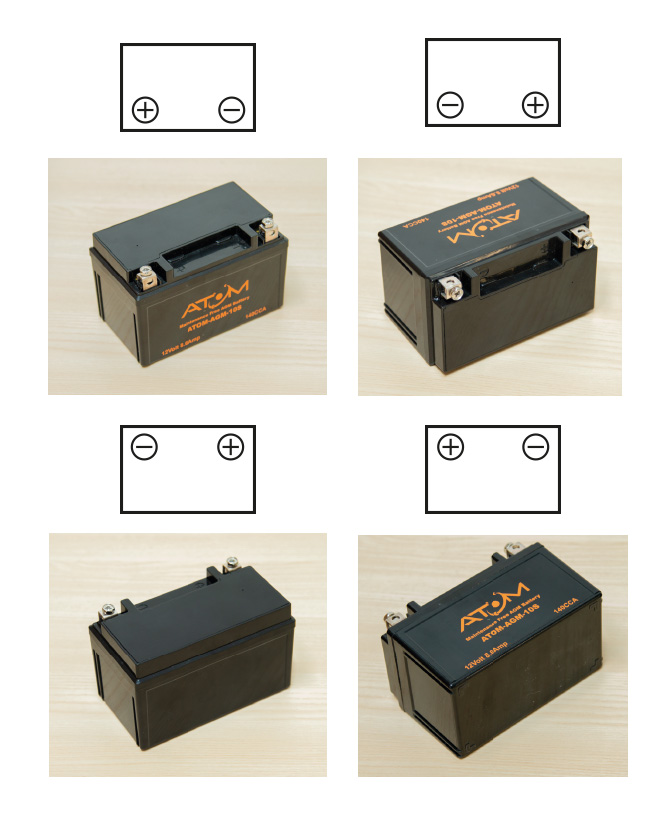
FAQs
How do I know which battery to get for my motorcycle?
If you have the owners manual for your bike, it will hopefully list the battery you require. The parts finder on the MPW website will allow you to filter any available products which fit your bike. Battery manufacturers also list fitment on their websites - Motobatt, Yuasa and Shido are useful places to search in order to get the right part number.
Once you know the battery code you need, you have to decide on the type of battery to get! Do you have a limited budget? If so, gel or VRLA are a good option. Do you need a bit more cranking power to start your bike? Get an AGM. Is money no option? Do you want something super lightweight? Buy lithium! A good all round, high performing option for most applications is the AGM battery, though they can be heavy. You don't necessarily need to replace your battery like for like, unless you want to. Just make sure the battery you choose is compatible with your bike. It is also worth noting that some brands use batteries which will replace a range of options, and so the battery code you need may not match the original battery on your bike.
Can I start my motorcycle with a dead battery?
You may be able to bump start your bike, but even this may not work if another component in the charging system is the reason it stopped working. If you left your lights on and the battery is dead, a bump start should get you going.
How do I know if my motorcycle battery needs replacing?
By performing the tests mentioned at the beginning of this article, you should be able to establish if you need a new battery. You need to ensure you are diagnosing the correct part of the charging system that is causing the issue - people will often buy a new battery as that is a nice easy solution, but if your reg/rec or stator is fried, this isn't going to do you a lot of good in the long run!
What happens if a motorcycle battery is low?
You will notice that your lights are dim and your bike might also struggle to turn over, or turn over very slowly. If your battery is completely dead, you might hear a buzz or a click from your starter and very little else.
How Long Does a Motorcycle Battery Last?
This will depend on how often you use your bike, the quality of the battery and the type of riding you do. If you fit a cheap battery to your adventure bike and only do short trips down rocky trails, the stop/start riding, vibration and poor build quality will likely result in an unhappy battery. On the other hand, if you use your bike regularly and give the battery a chance to charge with a decent ride, it should last several years.
Where a lot of batteries tend to die is when a motorcycle is left unloved over winter. If you do not use a trickle charger to top up your battery, you'll likely come back to your bike in spring and it won't start. Alternatively you can charge your battery every month or two, to ensure the voltage doesn't drop too low.
What causes a motorcycle battery to stop holding a charge?
Over time a battery will develop lead sulfate on the plates when not in use. Charging and using the battery will break down this sulfation. If allowed to develop for an extended period, the sulfation on the plates will thicken and limit the charge that the battery can hold. This is the primary reason a battery will not charge. Some battery chargers include a desulfation mode which can potentially reverse the effects of a sulfated battery. If you fully charge your battery and it refuses to go above 12.4v, it'll be sulfated.
Will a Motorcycle Battery Charge at Idle?
A motorcycle battery will charge at idle, but the charge provided will be a lot lower than going for a ride. Simply starting a bike, letting it idle, then turning it off can actually be detrimental to the battery as it takes a lot of energy to initially start the bike. Variation in engine speed will provide more current to charge the battery, so it is always best to go for a decent ride in order to charge your battery properly.
What do the numbers and letters in the battery code mean?
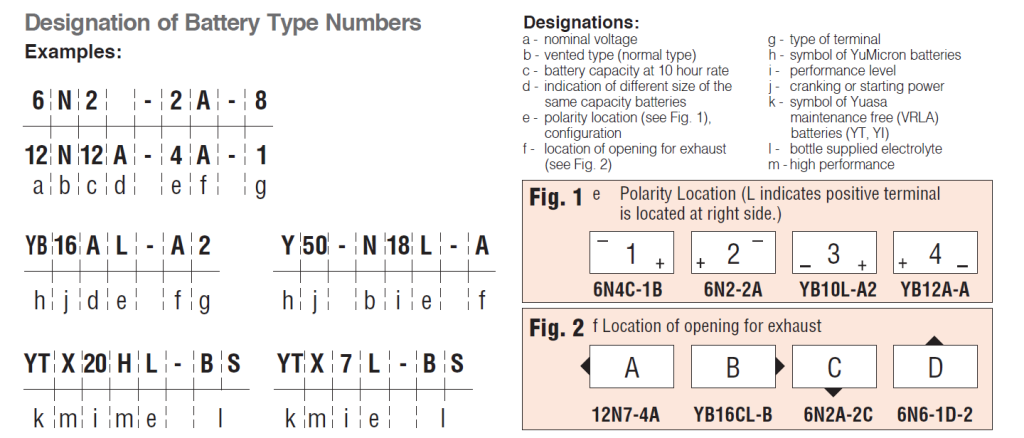
YT - Yuasa VRLA code
N - Vented Type
X - High Performance
Z - High Performance
L - negative terminal on the left hand side
7 - battery performance indicator
BS - Bottle Supplied
Batteries with codes starting with numbers identify a traditional style lead acid battery. 6 = 6 volt, 12 = 12 volt.
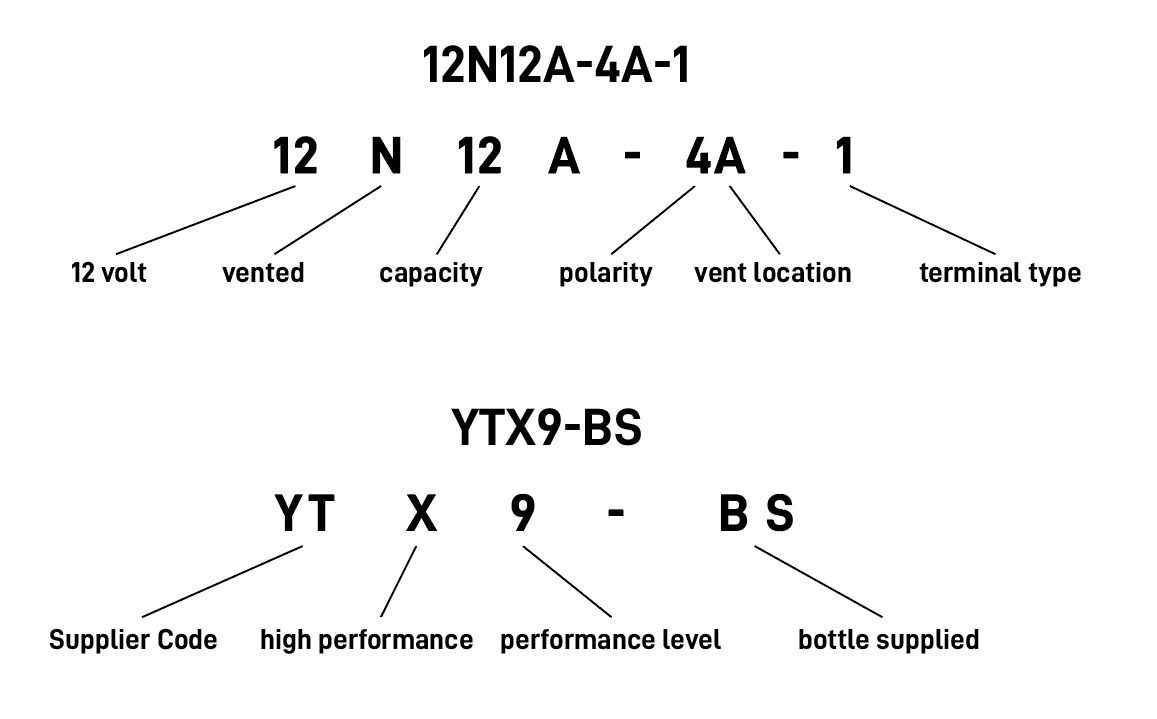
Can a Motorcycle Battery Be Repaired?
There are ways to recover a dead battery, but it is often more cost effective to simply buy a new one. Some chargers have a desulfation mode which can help to recover a battery. Even if you can recover the battery, it will often have a lower capacity than when it was new.
What is CCA?
CCA stands for cold cranking amps - this is a measure of the performance of a battery measured at -18ºC for 30 seconds without dropping below 7.2 volts. The higher the number, the more easily it will start your bike. If you have a large capacity motorcycle, you'll want a decent CCA figure to ensure the bike will turn over fast enough. You can often find a recommended CCA figure for your bike online, or in a workshop manual.
What does Ah mean?
Ah (amp hours) is an indication of the capacity of the battery, showing you how long it will last when a 1 amp current is drawn from it. For example, a 12Ah battery will last 12 hours with a 1 amp draw, six hours with a 2A, two hours with a 6A draw and so on. The higher the Ah number, the longer the battery is able to last. If you have a lot of accessories fitted to your bike (heated gloves, immobiliser, sat nav, microwave etc) a battery with a higher Ah rating will maintain a greater draw in power for longer.
Conclusion
Hopefully that clarifies some of the issues you may experience with your battery and gives you an idea of the next type of battery you might want to get for your bike. If you want to learn more about troubleshooting your charging system, check out our other article.
